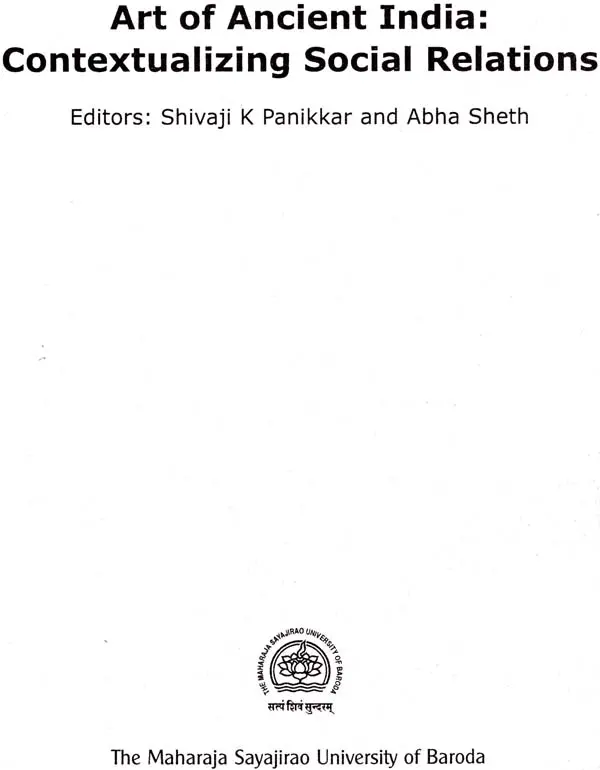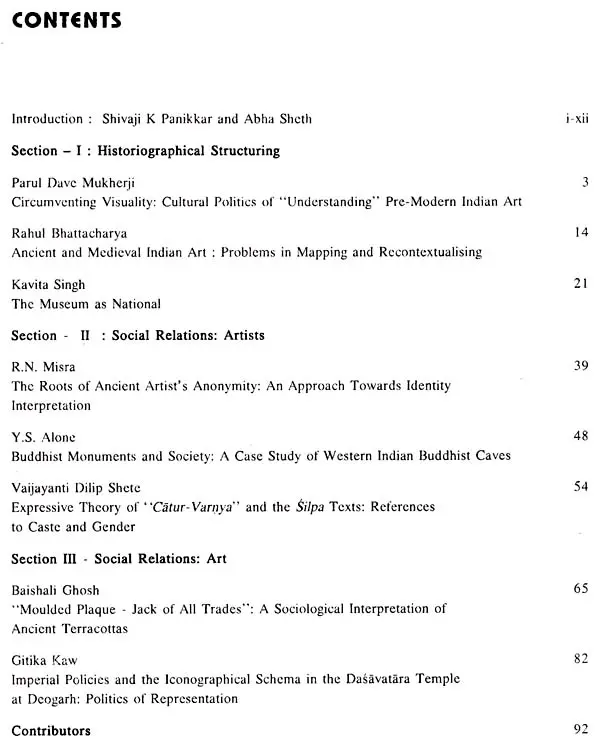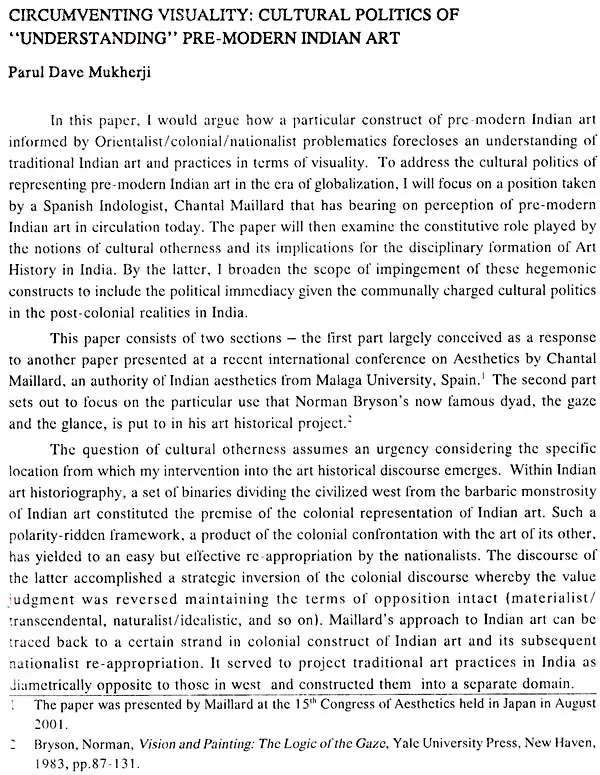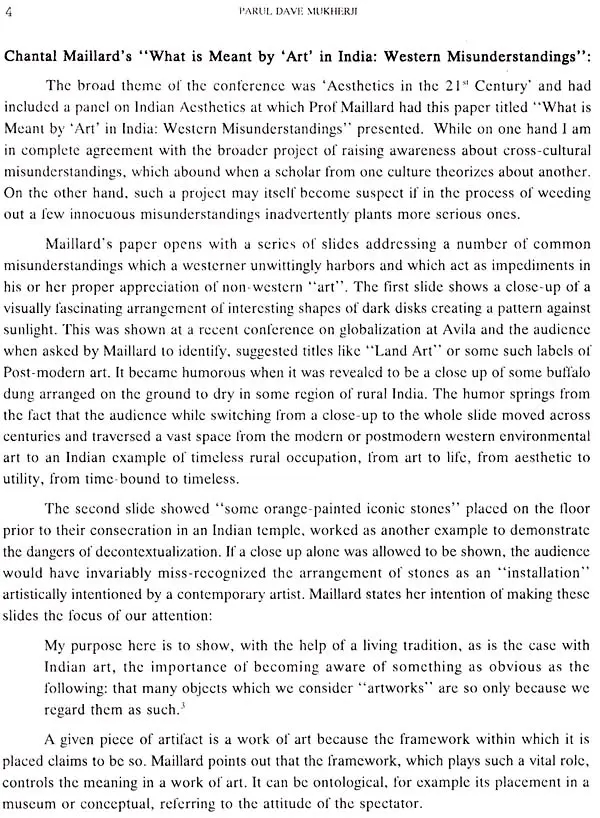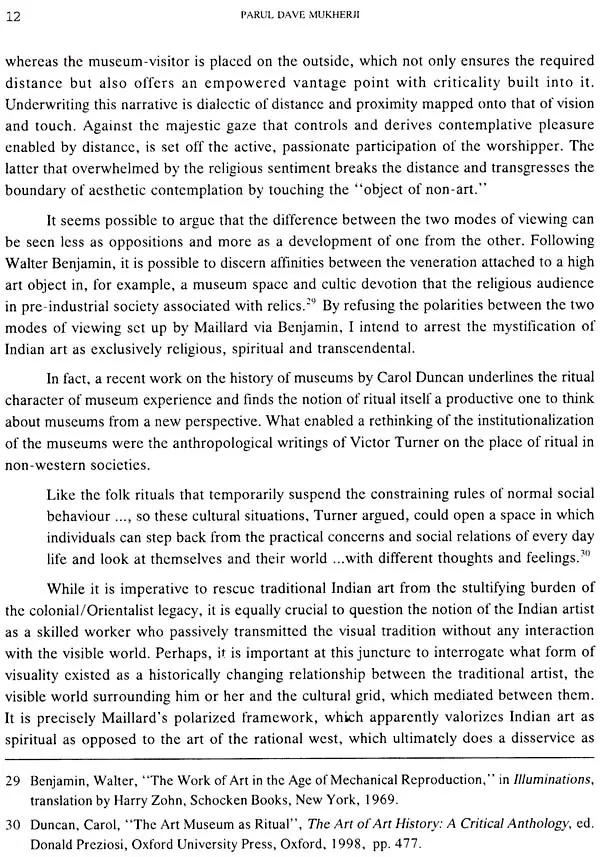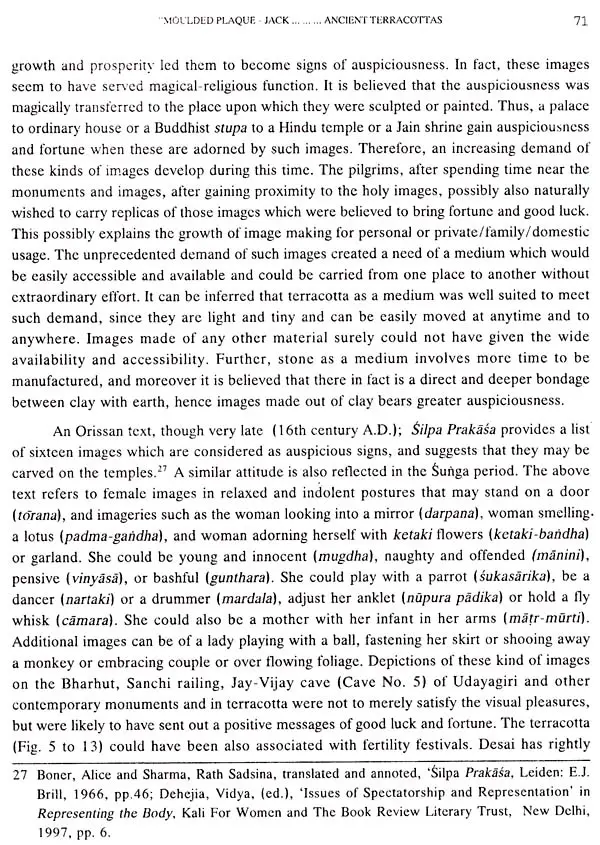
Art of Ancient India: Contextualizing Social Relations
Book Specification
| Item Code: | UAQ374 |
| Author: | Shivaji K Panikkar & Abha Sheth |
| Publisher: | The Mahraja Siyajirao University of Barodra |
| Language: | English |
| Pages: | 93 |
| Cover: | PAPERBACK |
| Other Details | 9.50 X 7.50 inch |
| Weight | 230 gm |
Book Description
A National level conference titled Theorizing India's Pre-Modern Visual Culture: Issues of Class, Caste, Gender and Sexualities was held at the Department of Art History and Aesthetics, The Maharaja Sayajirao University of Baroda, Baroda, on February 13th, 14th and 15th, 2003. The focus of the conference centered around this theme since the art historiography of pre-modern India presents a definite lack of interpretations implicating critical issues, particularly dealing with the questions of caste, class, gender, and sexual minorities. Although there has been a growing interest during the last couple of decades in the direction of "New Art History", the dominant mode of scholarship on Indian art remains conservative; still the formalist analysis of stylistic categories and their evolution, various schools and mutual influences or autonomy, iconographical or narrative descriptions, and to a lesser extent iconological interpretations are its prime concerns, and of late there had been critical views on these. In any case, in most studies, there is a glaring absence of relating art and its histories to social, political dynamics; the socio-political economic texts and their contents in relation to specific historical contexts. The purpose of the conference was to address this lacuna by re-examining pre-modern traditions of Indian art from the point of view of class, caste and gender identities and politics. It hoped to critically engage with, or even attempt to dislodge the currently prevalent paradigms of the Art Historical discipline that is slotted-in with an art-object oriented approach that deal primarily with issues of authorship, connoisseurship, attribution and chronology. It was growingly being felt that different framework oriented approaches should replace these, as the shift could give importance to political, social and economic structures that under gird the production and consumption of art.
The conference's concern in part had grown out of an increasing discomfort with the disciplinary framework of an Art History that could hardly explain the field of the history of visual culture in its totality, informed and implicated in history, and the need indeed was felt for lending a new life to the pre-modern Indian art from radical perspectives. Frankly, the said purpose was not wholly fulfilled by the conference. However, it is to be conceded that it was a step forward in critically considering the existing, available frameworks/perspectives of Indian art historical studies. The achievement of the conference as a whole was modest, yet it was a significant supplement in the direction of interpreting pre-modern Indian art; its varied objects, monuments and institutions within the subcontinents' socio-politico-historical flux. As such the papers that were presented earnestly displayed a growing general interest in analyzing art within the critical categories of differences between various classes, castes and genders. This was so since most of the presentations generally though, but definitively related art history to the specific historical contexts in which they were produced and consumed/viewed. In other words, to a certain extent the very relation of art to the sociological, political and economic circumstances that produced meanings in specific contexts was subjected to critical scrutiny.
During the three days of the conference twenty two papers were presented. Three papers were solely conceptual in nature; as they attempted to critically deal with the dominant frameworks of looking at pre-modern art history - these included the presentations of Parul Dave Mukherji (Circumventing Visuality: Cultural Politics of "Understanding" Pre-Modern Indian Art). Rahul Bhattacharya (prachin aur madhyakalin bharat ki kala/Ancient and Medieval Indian Art: Problems in Mapping and Recontextualising), and Kavita Singh (The Museum as National), which are included at the outset of this publication.
The papers by R.N. Misra (Crafting Alternative Futures: A Note on Ancient Artist's Prescribed Status, Dissent and After), Y.S. Alone (Buddhist Monuments and Society: A Case Study of Western Indian Buddhist Caves), and Vaijayanti Shete (The Expressive Theory of "Châturvarnya": Outlining the Texts) dealt with specific issues related to the social identity of the artists in ancient India. The presentations of Baishali Ghosh ("Mould - Plaque - Jack of all Trades"), A.P. Jamkhedkar (Caste and Class - A Historical Perspective), Ratan Parimoo (Saundarananda Sculptural Relief from Goli Stupa and its Hermeneutic Interpretation), Gitika Kaw (Gupta Imperial Policies and Iconographical Schema at Deogarh), Abha Sheth (Proposing an "Autonomous" Saptamatrika Cult - Case Study of Pre-Medieval Sculptures of North Gujarat and South West Rajasthan), and Kumkum Roy (Representations of Gender Relations in Early India: Exploring the Plays of Kalidasa), while dealing with ancient period, choose to engage with varied concerns ranging from technical aspect of art production to iconography, narration and its interpretations, or with facts of castes and classes in ancient India as such.
**Contents and Sample Pages**
